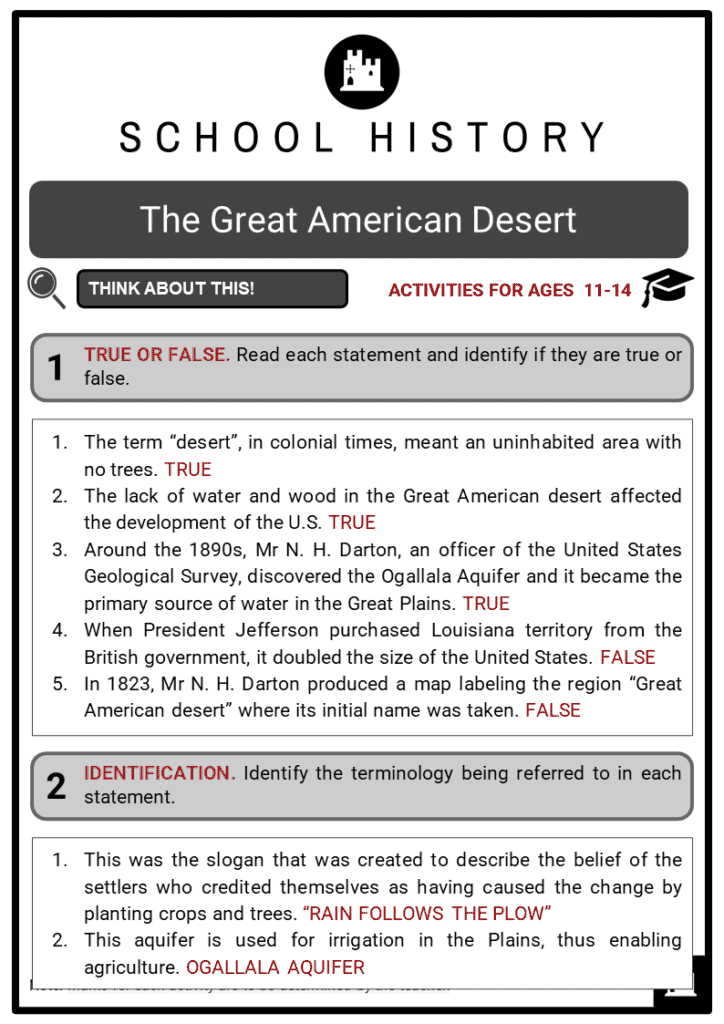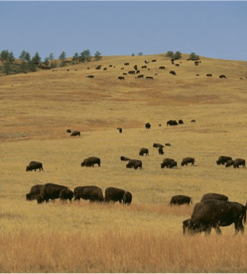Download The Great American Desert Worksheets
Do you want to save dozens of hours in time? Get your evenings and weekends back? Be able to teach The Great American Desert to your students?
Our worksheet bundle includes a fact file and printable worksheets and student activities. Perfect for both the classroom and homeschooling!
Table of Contents
Add a header to begin generating the table of contents
Summary
- The Concept of “desert”
- From the Great American Desert to the Great Plains
- Alienation of the Natives from the Great Plains
Key Facts And Information
Let’s find out more about The Great American Desert!
- From the 1820s to 1860s, all the area west of the Mississippi River was called the Great American Desert. The discovery of minerals and the Ogallala Aquifer transformed the so-called Great American desert to the Great Plains which had become among America’s most profitable centres. Upon the discovery of wealth in the region, Native Americans were alienated from the Great Plains and forced to move to reservations where they had to change their traditional way of life.
The Concept of “desert”
- The term “desert”, in colonial times, meant an uninhabited area with no trees. By the 19th century, the term began to form a new meaning, one with a connotation of “unfit for farming”.
- The zone west of the Mississippi River up to the Rocky Mountains was called the Great American Desert. Settlers considered the area undesirable due to its extreme weather conditions and lack of wood and water making the area unfit for farming with the methods available at the time. The region was flat with no trees and ferocious winds. Wolves and locusts were also present in the area with the only inhabitants being the Native Americans.
- When the Great American desert was obtained in 1803 through the Louisiana Purchase that doubled the size of the United States, then-President Thomas Jefferson wrote that the region had “immense and trackless deserts”.
- Moreover, in 1823, the leader of the next official exploration expedition, Major Stephen Long, produced a map labeling the region “Great American desert” where its initial name was taken. He described the area as “uninhabitable by a people depending upon agriculture for their subsistence.”
- By the middle of the 19th century, the connotation of “desert” was seen to be false as people migrated to the region. It was, however, still seen as uninhabitable until irrigation and railroad transportation made up for the lack of surface water and wood.
From the Great American Desert to the Great Plains
- The lack of water and wood in the Great American desert affected the development of the U.S. Whenever settlers headed westward, they usually passed by the region as quickly as possible because it wasn’t considered desirable. Some of them even gave names like “Sweetwater Creek” or “Poison Creek” to the various streams located in the region.
- The Natives living in the area at the time, however, were flourishing. There were abundant herds of buffalos, which was a source of food and hide, useful for making clothes and houses. Their Native dwellings were called teepees (or tipis), consisting of wooden poles anchored to the ground in a cone-shape and covered with buffalo hide. Other animals that inhabited the region were the black-footed ferret, pronghorn antelope, foxes, deer, and grassland birds.
- Parts of a Teepee:
- Poles - To make a cone shape, up to 20 poles are bound together at the top of the tipi
- Smoke flap - The flap can be adjusted to keep in heat or air out the inside of the tipi
- Buffalo hide - The poles are draped with buffalo skin
- Pins - To fasten the tipi, wooden pins are used. The pins could be easily removed so that the tipi can be folded up during travels
- Design - Traditional painted designs are decorated on the tipi
- Entrance - The entrance is faced on the east to protect against west winds
- Over time, the expanse of the Great American desert acquired the name the Great Plains and with the discovery of minerals in the late 1850s in Nevada and Colorado, miners rushed to Idaho and Montana in the 1860s. Further, the settlers began to realise that the desert areas only began west of the Rocky Mountains ranges.
- Despite the poor reputation of the region, the mid-19th century saw Americans settling in the west. This was when local inhabitants came to realise that the region was suited for farming. Some experts theorised that climate had changed in the area. The slogan “rain follows the plow” was created to describe the belief of the settlers who credited themselves as having caused the change by planting crops and trees.
- Streams and aquifers were critical sources of water in the region. Around the 1890s, N. H. Darton, an officer of the United States Geological Survey, discovered the Ogallala Aquifer and it became the primary source of water. The aquifer sits under eight states ranging from South Dakota south to Texas and New Mexico. The early 1900s would see the Ogallala aquifer used for irrigation in the Plains, thus enabling agriculture.
- By the turn of the 1860s, the region had witnessed a transformation to become America’s economic pivot with the exploration of mineral deposits such as gold and silver. During this time thousands of people moved west towards this region. These led to population growth that brought about the springing up of new towns; a phenomenon called America’s westward expansion.
- There was an economic boom in this period that opened opportunities for farms, ranches and railroad construction for further development. Ranchers in the Great Plains amassed huge profits raising cattle. Due to the lack of rainfall, farmers in the Great Plains were innovative with some drilling wells to access water. In recent times, the area of the Great Plains is now usually referred to as the High Plains, whereas the original term is used to describe the arid region of North America.
Alienation of the Natives from the Great Plains
- Ever since arriving, the pioneers of the United States have been expanding the country westward. This was because there was cheap and fruitful land in the West, mining opportunities, expanding railroad for easy access to supplies, etc.
- When President Jefferson purchased Louisiana territory from the French government, it doubled the size of the United States. For Jefferson, the westward expansion was necessary to sustain an ideal population, particularly a population of independent and virtuous farm owner citizens.
- Nonetheless, Jefferson’s plan for westward expansion faced a lot of opposition mainly from Native Americans who suffered the greatest loss. As new settlers moved in, they were forced to relegate in reservations--losing their traditional way of life.
- At first, the Native Americans allowed ‘white’ settlers into the Great Plains without resistance, but soon the European settlers wanted all the land in the Plains to themselves. The Natives maintained a spirited fight for their rights over the area in the Plains, but Congress passed a series of policies to exclude the Natives from the land, and the federal government implemented them, taking lives and livelihood from the natives.
Image sources:









